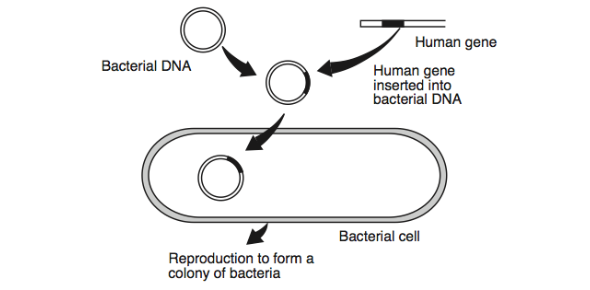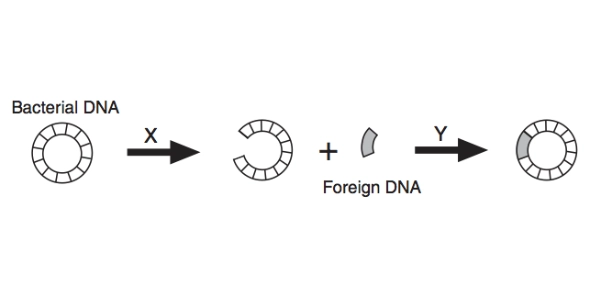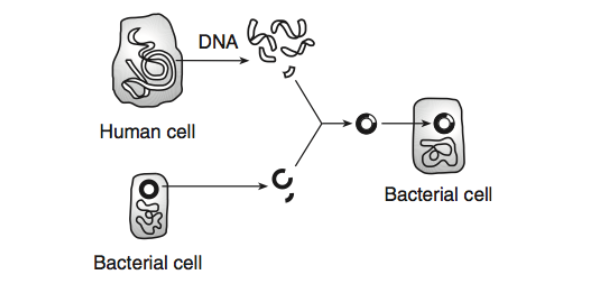Genetic Engineering MCQ: Quiz!
(177).jpg)
Welcome to the Genetic Engineering MCQ Quiz! Test your knowledge and understanding of the fascinating field of genetic engineering with these thought-provoking multiple-choice questions. Whether you're a biology enthusiast or just curious about the wonders of genetic manipulation, this quiz will challenge you and expand your understanding. From the basics of DNA splicing to the applications of genetic engineering in various fields, this quiz covers it all. Get ready to dive into the world of genetic engineering and see how well you fare! Let's get started and unravel the secrets of genetic engineering!
- 1.
In genetic engineering, what occurs during step 3?
- A.
A new type of molecular base is formed
- B.
Different types of minerals are joined together
- C.
DNA from the bacterial cell is cloned
- D.
DNA from different organisms is joined together
Correct Answer
D. DNA from different organisms is joined togetherExplanation
During step 3 of genetic engineering, DNA from different organisms is joined together. This process is known as DNA recombination or genetic recombination. It involves the insertion of a specific gene or DNA segment from one organism into the DNA of another organism. This allows scientists to combine desirable traits or create new genetic combinations for various purposes, such as improving crop yield, producing pharmaceuticals, or studying gene function. By joining DNA from different organisms, genetic engineers can manipulate and modify the genetic makeup of organisms to achieve desired outcomes.Rate this question:
-
- 2.
The diagram below represents a genetic procedure. What is the primary outcome of this procedure?
- A.
Bacterial cells will destroy defective human genetic material.
- B.
Bacterial cells may form a multicellular embryo.
- C.
The inserted human DNA will change harmful bacteria to harmless ones.
- D.
The inserted human DNA may direct the synthesis of human proteins.
Correct Answer
D. The inserted human DNA may direct the synthesis of human proteins.Explanation
The primary outcome of this genetic procedure is that the inserted human DNA may direct the synthesis of human proteins. This means that the genetic material from humans is being introduced into bacterial cells, and these cells have the potential to produce proteins that are typically found in humans. This can have various applications in biotechnology and medical research, such as producing therapeutic proteins or studying human genetic disorders.Rate this question:
-
- 3.
The diagrams below represent some steps in a biotechnology procedure. Letters X and Y represent:
- A.
Hormones that stimulate the replication of bacterial DNA
- B.
Biochemical catalysts involved in the insertion of genes into other organisms
- C.
Hormones that trigger rapid mutation of genetic information
- D.
Gases needed to produce the energy required for gene manipulation
Correct Answer
B. Biochemical catalysts involved in the insertion of genes into other organismsExplanation
The diagrams represent a biotechnology procedure, and the letters X and Y are biochemical catalysts involved in the insertion of genes into other organisms. This means that X and Y are enzymes or proteins that facilitate the transfer of genetic material from one organism to another. These catalysts play a crucial role in genetic engineering and allow scientists to manipulate the genetic information of organisms.Rate this question:
-
- 4.
The diagram below represents a common laboratory technique in molecular genetics. What is one common use of this technology?
- A.
Production of a human embryo to aid women who are unable to have children.
- B.
Change of single-celled organisms to multicellular organisms.
- C.
Introduction of a toxic substance to kill bacterial cells.
- D.
Production of hormones or enzymes to replace missing human body chemicals.
Correct Answer
D. Production of hormones or enzymes to replace missing human body chemicals. -
- 5.
The headline "Improved Soybeans Produce Healthier Vegetable Oils" refers to a biotechnology process most likely known as:
- A.
Genetic engineering
- B.
Asexual reproduction
- C.
Natural selection
- D.
Habitat modification
Correct Answer
C. Natural selectionExplanation
The headline "Improved Soybeans Produce Healthier Vegetable Oils" suggests that the process of producing healthier vegetable oils from soybeans has been improved. This improvement is most likely achieved through natural selection, where soybeans with desirable traits for producing healthier oils are selected and bred, leading to the development of improved soybeans. Genetic engineering, asexual reproduction, and habitat modification are not mentioned in the headline and therefore not the most likely processes involved in this context.Rate this question:
-
- 6.
Scientists genetically modify goats with a human gene for a blood anti-clotting factor. How are these genetically modified goats most likely produced?
- A.
Injected the anti-clotting factor into the milk-producing glands of the animals.
- B.
Added modified DNA into the milk of the animals.
- C.
Inserted the human gene into the egg cells of goats.
- D.
Altered the nutritional requirements of newborn goats.
Correct Answer
C. Inserted the human gene into the egg cells of goats.Explanation
To produce genetically modified goats with a human gene for a blood anti-clotting factor, the most likely method used is to insert the human gene into the egg cells of goats. This allows for the gene to be incorporated into the genetic material of the goats, resulting in the production of offspring with the desired genetic modification. Injecting the anti-clotting factor into the milk-producing glands or adding modified DNA into the milk would not result in genetic modification of the goats themselves. Altering the nutritional requirements of newborn goats is unrelated to the process of genetically modifying them.Rate this question:
-
- 7.
What best describes human insulin produced by genetically engineered bacteria?
- A.
Produced through exposure of bacteria cells to radiation, resulting in a mutation.
- B.
May have fewer side effects than insulin extracted from the pancreas of other animals.
- C.
Will not function normally in humans because it is produced by bacteria.
- D.
Produced by inserting human insulin into bacteria cells.
Correct Answer
D. Produced by inserting human insulin into bacteria cells.Explanation
Human insulin produced by genetically engineered bacteria is produced by inserting the gene that codes for human insulin into the bacteria cells. This allows the bacteria to produce human insulin, which can then be harvested and used as a medication for individuals with diabetes. This method of production is more efficient and cost-effective compared to extracting insulin from the pancreas of other animals. Additionally, human insulin produced in this way is identical to the insulin naturally produced by the human body, making it highly effective in managing blood sugar levels.Rate this question:
-
- 8.
Genetic engineering is also referred to as:
- A.
Genetic modification
- B.
Genetic manipulation
- C.
Genetic repairing
- D.
Both A and B
Correct Answer
D. Both A and BExplanation
Genetic engineering is a term used to describe the manipulation and modification of an organism's genetic material. This can be achieved through various techniques, such as introducing new genes or altering existing ones. The terms "genetic modification" and "genetic manipulation" are often used interchangeably to refer to this process. Therefore, the correct answer is "Both A and B" because both terms are commonly used to describe genetic engineering.Rate this question:
-
- 9.
Which technique is commonly used to transfer genes into plant cells?
- A.
Polymerase chain reaction (PCR)
- B.
Southern blotting
- C.
Agrobacterium-mediated transformation
- D.
Gel electrophoresis
Correct Answer
C. Agrobacterium-mediated transformationExplanation
Agrobacterium-mediated transformation is commonly used to transfer genes into plant cells. Agrobacterium is a bacterium that naturally transfers a piece of its DNA, known as the T-DNA, into plant cells, causing a genetic transformation. This technique involves using Agrobacterium as a vector to introduce desired genes into the plant genome. The T-DNA is integrated into the plant's DNA, allowing the transferred genes to be expressed and potentially change the plant's characteristics. This method is widely used in plant biotechnology for genetic engineering and crop improvement.Rate this question:
-
- 10.
What is the purpose of a selectable marker in genetic engineering experiments?
- A.
To distinguish genetically modified organisms from non-modified ones
- B.
To induce mutations in the target gene
- C.
To identify specific DNA sequences
- D.
To enhance the efficiency of gene transfer
Correct Answer
A. To distinguish genetically modified organisms from non-modified onesExplanation
The purpose of a selectable marker in genetic engineering experiments is to distinguish genetically modified organisms from non-modified ones. Selectable markers are genes that are introduced into the organism along with the target gene. These markers provide a way to identify which organisms have successfully taken up the target gene and are genetically modified. This allows researchers to selectively grow and analyze only the genetically modified organisms, while discarding the non-modified ones. By using selectable markers, researchers can easily identify and track the presence of the target gene in the organisms being studied.Rate this question:
-
Quiz Review Timeline +
Our quizzes are rigorously reviewed, monitored and continuously updated by our expert board to maintain accuracy, relevance, and timeliness.
-
Current Version
-
Feb 08, 2024Quiz Edited by
ProProfs Editorial Team
Expert Reviewed by
Stephen Reinbold -
Jan 07, 2013Quiz Created by
Ionca
 Back to top
Back to top






